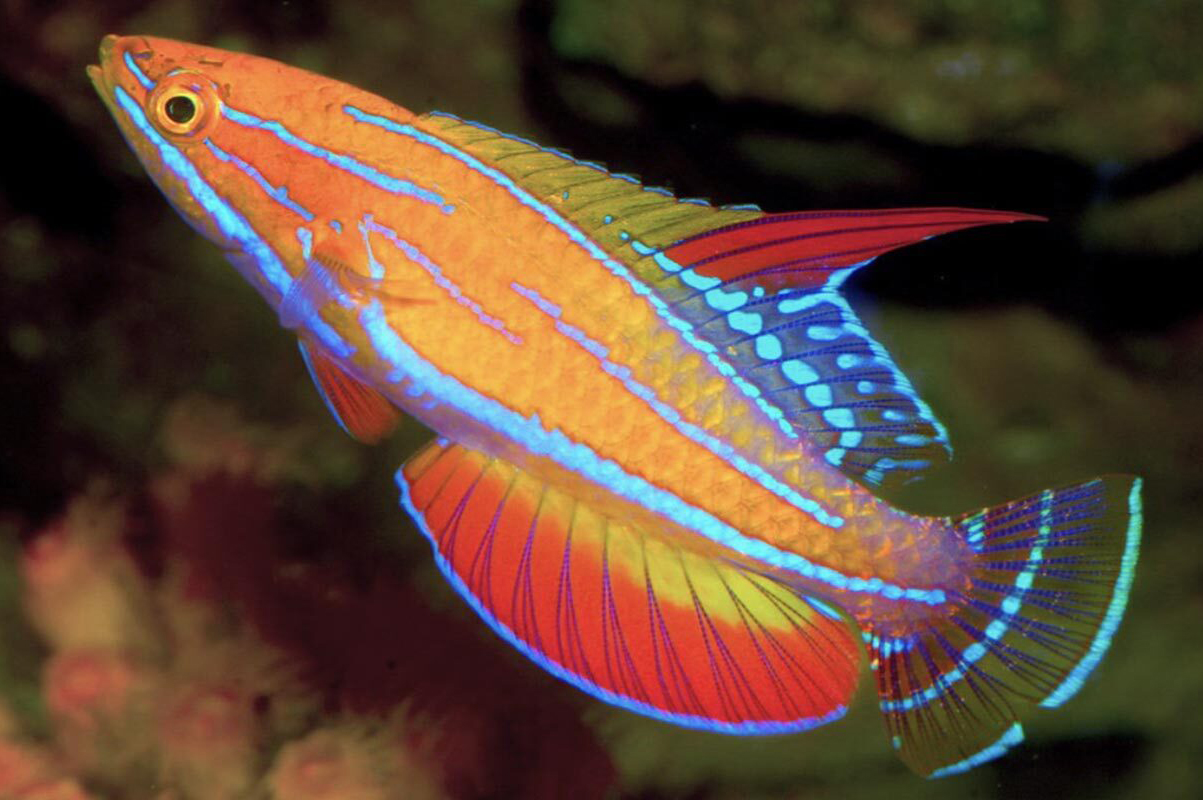Amanda’s Flasher Wrasse, Paracheilinus amanda Tea & Walsh 2023
Other Names: Red-tail Flasher Wrasse

A male (Terminal Phase) Redtail Flasherwrasse, Paracheilinus rubricaudalis (approx. 55 mm SL), on the Great Barrier Reef, Queensland, Australia. Source: K. Endoh, Fig. 47, in Allen, Erdmann & Yusmalinda (2016) Journal of the Ocean Science Foundation 19: 18–90.. License: CC by Attribution
Summary:
A small orange to orange-brown flasher wrasse with purplish-blue to bright neon blue body stripes. Males have a sharply bicolored anal fin that is yellow basally and reddish-orange distally, a yellow spinous dorsal fin, a single red dorsal-fin filament comprising three segmented rays bound by membrane, and a rounded caudal fin with two concentric blue bands.
In Australia, this species was previously misidentified as Paracheilinus rubricaudalis, which occurs in Fiji, Vanuatu and eastern Papua New Guinea.
In Australia, this species was previously misidentified as Paracheilinus rubricaudalis, which occurs in Fiji, Vanuatu and eastern Papua New Guinea.
Cite this page as:
Bray, D.J. 2023, Paracheilinus amanda in Fishes of Australia, accessed 17 Apr 2024, https://fishesofaustralia.net.au/Home/species/5235
Amanda’s Flasher Wrasse, Paracheilinus amanda Tea & Walsh 2023
More Info
|
Distribution |
Harrier Reef, Ribbon Reefs, northern Great Barrier Reef, Queensland, and Flora, Holmes and Osprey Reefs in the Coral Sea. Elsewhere the species occurs in southern Papua New Guinea. |
|
Features |
Soft dorsal fin of males consisting of three segmented rays bound by membrane. Caudal fin rounded. |
|
Colour |
Males: Head and body orange to orange brown with purplish blue to bright neon blue body stripes; iris bright orange with bright yellow ring around pupil; spinous portion of dorsal fin yellow; posterior soft dorsal fin hyaline overlain with bright metallic blue, sometimes breaking into indistinct spot-bands medially and on distal edge; first two to three interradial membrane spaces (including the filament) bright red; basal third of anal fin bright yellow, remainder distal portion of fin bright orange red, interphase of both colours usually without blue spots, or if present, usually incomplete and towards posterior portion of fin; distal-most edge of anal fin bright blue; caudal fin hyaline with a pair of concentric blue bands following contour of fin, first on basal third, second on outermost edge; pelvic fins reddish hyaline, bright blue on distal-most edge; pectoral fins hyaline. Females: Head and body orange to orange brown with purplish blue to neon blue body stripes, median fins yellow hyaline with indistinct blue markings. |
|
Feeding |
Feeds on plankton in the water column. |
|
Biology |
A protogynous hermaphrodite - all individuals start life as females, and the dominant female may change sex into a male during her life cycle. This transformation from female to male may take a couple of weeks. Flasherwrasses are broadcast spawners, releasing eggs and sperm into the water column. |
|
Etymology |
The species is named in honour of Amanda Hay, Ichthyology Collection Manager at the Australian Museum, Sydney. |
|
Species Citation |
Paracheilinus amanda Tea & Walsh 2023, Ichthyology and Herpetology 111(3): 402, Figs 3, 4, Fig. 5A1, 5A2, 7A. Type locality: Harrier Reef, Great Barrier Reef, 15°08'S, 145°41'E, 20 m. |
|
Author |
Bray, D.J. 2023 |
|
Resources |
Amanda’s Flasher Wrasse, Paracheilinus amanda Tea & Walsh 2023
References
Allen, G.R., Erdmann, M.V. & Yusmalinda, N.L.A. 2016. Review of the Indo-Pacific Flasherwrasses of the genus Paracheilinus (Perciformes: Labridae), with descriptions of three new species. Journal of the Ocean Science Foundation 19: 18–90. https://doi.org/10.5281/zenodo.46267 (in part as Paracheilinus rubricaudalis - aquarium specimen from Great Barrier Reef)
Tea, Y.-K. & Walsh, F. 2023. Review of Australian species of Paracheilinus Fourmanoir (Teleostei: Labridae), with description of a new species from the Great Barrier Reef and Coral Sea. Ichthyology and Herpetology 111(3): 397-415. https://doi.org/10.1643/i202301

